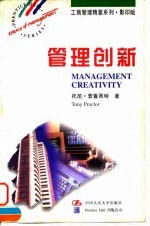
- 作 者:(英)托尼·普鲁西特(Tony Proctor)著
- 出 版 社:北京:中国人民大学出版社;普兰蒂斯霍尔出版公司
- 出版年份:1997
- ISBN:7300024734
- 标注页数:222 页
- PDF页数:232 页
请阅读订购服务说明与试读!
订购服务说明
1、本站所有的书默认都是PDF格式,该格式图书只能阅读和打印,不能再次编辑。
2、除分上下册或者多册的情况下,一般PDF页数一定要大于标注页数才建议下单购买。【本资源232 ≥222页】
图书下载及付费说明
1、所有的电子图书为PDF格式,支持电脑、手机、平板等各类电子设备阅读;可以任意拷贝文件到不同的阅读设备里进行阅读。
2、电子图书在提交订单后一般半小时内处理完成,最晚48小时内处理完成。(非工作日购买会延迟)
3、所有的电子图书都是原书直接扫描方式制作而成。
Contents 1
1. Creativity in management 1
Nature of creative thinking 1
The importance of creativity in management 2
Creative problem solving 4
The background of creative problem solving 4
Overview of the creative Problem-solving process 5
An IDEAL model for problem solving 8
二ow creative thinking may be used in management 10
Problem identification and defintion 12
Idea generation methods 13
Evaluating ideas 15
Implementing ideas 16
Computer assisted Creativity aids 16
References 17
2. Coping with blocks to creative problem solving 20
Information processing and problerm solving 21
Mind-set 23
Other barriers to creative problem solving 26
Blocks in an organizational setting 28
A climate for creativity and innovation 31
References 35
3. Theories of creativity 37
What is creative thinking? 37
What are ideas? 39
Theories of creativity 40
The cognitive theory of creativity 44
The brain as a human information processing system 47
How knowledge is stored in memory 48
SCRIPTS,DELTACTS and MOPS 50
How we get ideas:the index metaphor 51
References 54
4.Identifying the problem 56
Problem definition and redefinition 58
Methods of problem definition or redefinition 58
Redefinitional techniques 59
Analytical techniques 67
References 75
5.Morphological analysis and related techniques 76
Listing 76
Checklists 78
Cliches,proverbs and maxims 79
Attribute listing 81
Morphological analysis 82
SCIMITAR 85
Heuristic ideation technique 85
Component detailing 87
The Allen morphologizer 91
Sequence-attribute modification matrix 93
References 96
6.Brainstorming and its variants 97
Classical brainstorming 98
Main types of problem that can be tackled 100
composition of a brainstorming group 101
Conducting a brainstorming session 101
The process of brainstorming 102
Brainwriting game 106
Gordon-Little variation 107
Story boards 108
Trigger method 111
Refernces 111
7. Lateral thinking 112
vertical versus lateral thinking 112
Dim1ensions of latCral thinking 113
Analogies 124
References 126
8.Synectics and related approaches 127
Metaphors 127
Synectics 128
Nature of the psychological states 129
Membership of a synectics group 130
Features of synectics 132
Operational mechanisms 133
Synectics process 136
When to use synectics,and its limitations 143
References 143
9.Miscellaneous idea-generating methods 144
Visual metaphor 144
Mind-mapping 147
Value analysis 147
Force field analysis 148
Symbolic representations 149
Attribute analogy chains 151
Bionics 152
Free association 153
Story writing 154
Crawford sliP writing 156
Lotus blossom 157
Fishbone diagram 159
Scenario writing 160
Scenario day-dreaming 161
Cross-impact analysis 164
References 165
10.Evaluating ideas 166
Collating and sorting ideas 166
Evaluating ideas 168
Culling,rating and scoring screens 169
The Castle technique 170
Decision balance sheet 171
Creative evaluation 171
Disjointed incrementalism 173
Goalstorming 173
Highlighting 174
Reverse brainstorming 175
Sticking dots 176
Weighting systems 177
Multifactor matrix 177
Choosing an evaluation method 181
References 181
11.Implementing ideas 183
Blocks to getting ideas adopted 183
Putting ideas into practice 186
Reducing resistance to change 188
Coping with criticism 189
Consensus mapping 189
Potential problem analysis 191
Research planning diagrams 194
PERT techniques 196
Post implementation 199
References 199
12.Computer assisted creatlvity 201
Role of computers in creativity 202
Computer assisted idea generation for individuals 203
Restructuring thoughts 207
Group creative problem-solving aids 211
Evaluation of the alternatives 214
Implementation of ideas 214
Conclusion 215
References 216
Further reading 218
Index 219
